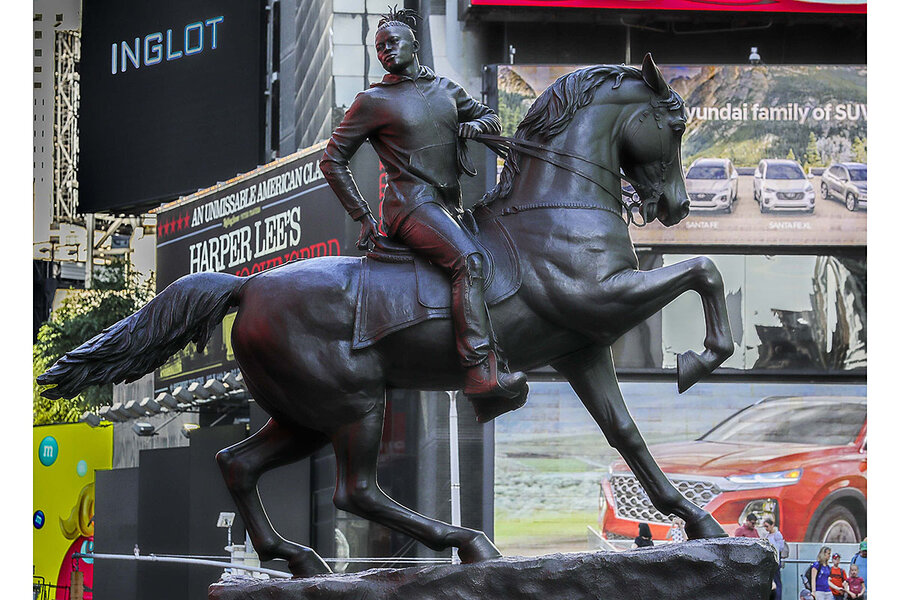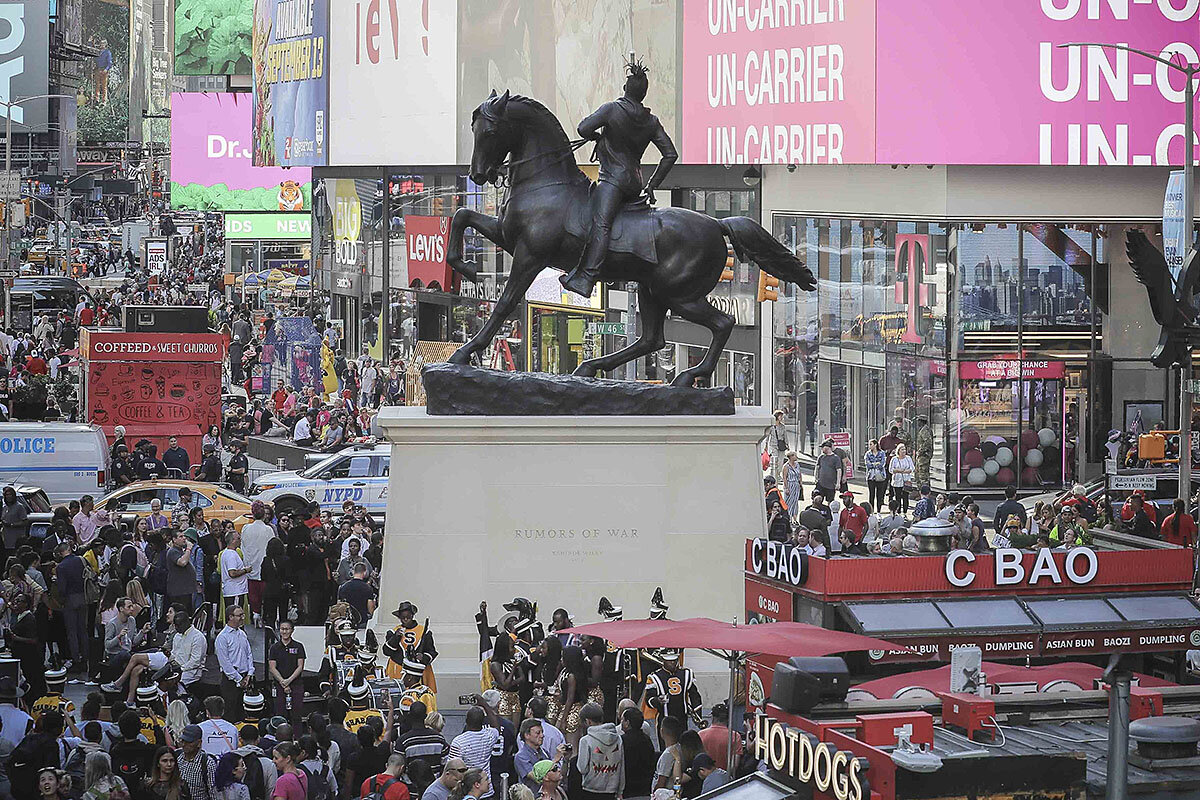A Confederate statue ... in a hoodie?
Loading...
| New York
When Kehinde Wiley walked down Monument Avenue in Richmond, Virginia, a few years ago, the towering statues of Confederate generals, memorialized on horseback in heroic battle pose, made a deep impression.
On one hand, the monuments filled him with “a sense of dread and fear,” celebrating a regime that fought to uphold slavery.
As an artist, however, Mr. Wiley also marveled. The epic monumentality, the romanticism, the power of images of the human body in action – these heroic forms of equestrian sculpture were something he could “say yes” to. And that sparked an idea.
Why We Wrote This
A famous artist is turning the debate about Confederate statues on its head. By appropriating and reimagining the classic wartime statue, Kehinde Wiley wants to glorify the freedom and dignity that slavery tried to stamp out.
“We come from a beautiful, fractured, sometimes terrible past,” Mr. Wiley said in September during the unveiling of his own towering equestrian statue, “Rumors of War,” now on display in Times Square in New York City. “But I think the job of artists is to take all of those myriad pieces, to be able to imagine them coming back together, to be able to look at yourself. ... Whoever you happen to be, [you] should be able to see yourself in this place we call America.”
It’s an optimistic, transformative vision that informs the work of Mr. Wiley, who painted the official portrait of President Barack Obama for the National Portrait Gallery in Washington. Now he is applying that worldview to America’s conversation about Confederate statuary.
“Rumors of War” is an ironic homage to the famous Monument Avenue statue of Confederate Gen. J.E.B. Stuart, almost to the point of parody. It depicts a young black man wearing Nike sneakers and a hoodie, his hair braided and tied into a top-springing plume, and looking over his shoulder as he sits astride his own high-stepping horse in a battlelike pose.
Commissioned by the Virginia Museum of Fine Arts, “Rumors of War” will take up its permanent place a few blocks south of the Confederate monuments in December, offering a countervision of both American heroism and the kinds of historical figures memorialized in the past.
“There’re these kinds of legible ways through which we understand identity, like these conventional equestrian statues that celebrate the heroic warrior,” says Tiffany Barber, professor of Africana studies at the University of Delaware in Newark. “Part of Wiley’s larger project has been to insert black subjects into that canon, appropriate those forms of picturing the self, and elevating the black figure to be either on par or even surpass the kinds of conventions of portraiture that we’ve been living with.”
It “signals to today’s youth that, much like their freedom-fighting ancestors, they too are up to the task,” adds Daniel Fountain, professor of history at Meredith College in Raleigh, North Carolina.
But the 27-foot bronze statue goes further. “Rumors of War” is a direct reference to Jesus’ warnings in the Gospel of Matthew about the coming of God’s judgment.
“It refers to a changing of times,” Mr. Wiley said during the September unveiling. “I’m not particularly religious, but I love the metaphor of changing stuff. The idea is that, in the change times, there are going to be wars, and rumors of wars. ... You have to recognize that the nature of human beings is to have this type of strife, to be in moments politically, socially where we are right now.”
Mr. Wiley said the passage is not necessarily apocalyptic. Such things must happen, but the one who stands firm to the end will be saved.
“There’s people like me ... who have devoted their lives to creating war calls, a call to arms, a call that says, I’m mad as hell, and I’m not going to take it anymore,” he said. “This is my America, too.”
In combining scripture with Confederate imagery, Mr. Wiley is challenging viewers to rethink what is holy and heroic.
“Within Wiley’s statue there really is this idea of the divine warrior who comes in to make matters right, to make things straight,” says Corey Walker, a visiting professor at the University of Richmond.
“These monuments really stage an anxiety that’s at the heart of American society and Western civilization,” Dr. Walker adds. “And that anxiety is really the very terror of modernity, and that is, the emerging freedom of these black bodies to reimagine and recreate a whole new world.”
That is a powerful statement, he says.
“Imagine, we will soon have a 27-foot statue speaking to Monument Avenue in the heart of the former capital of the Confederacy,” says Dr. Walker, who is also a senior fellow at the Freedom Forum Institute in Washington. “A statue that’s speaking back and saying, ‘The terror that you represent is now being re-reimagined as the possibility of the founding of a new nation.’”
Editor note: This story has been updated to correct the month of the sculpture's unveiling. It was in September.







